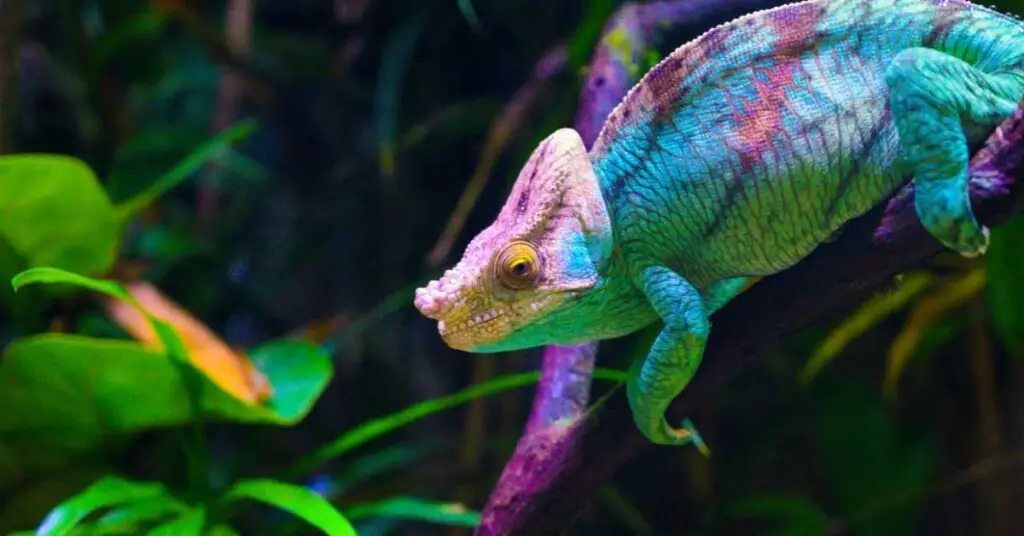We’re an affiliate. We may earn a commission on qualifying purchases through the links on this page. Learn more by reading our disclaimer.
Are chameleons warm or cold blooded? Chameleons are cold-blooded reptiles. This means that they need to bask in warm light in order to raise their body temperature and sit in a cool place when they want to lose heat. They use their environment to regulate their body temperature in order to stay happy and healthy.
Chameleons are one of the most fascinating creatures on earth. In addition to using a sun-soaked branch to bask or a shaded spot to cool down, they are able to change their color and blend in with their surroundings, making them almost invisible.
But are chameleons warm or cold-blooded?
This is a question that many people are curious about. In this blog post, we will answer that question and discuss other interesting facts about chameleons!
Are Chameleons Warm or Cold Blooded?
Chameleons are cold blooded and are what is known as ectothermic, which means that they rely on external sources of heat to warm their bodies.
In the wild, they bask in the sun to raise their body temperature. However, they can also absorb heat from their surroundings, such as a warm rock or branch.
As a result, chameleons can survive in a variety of different environments.

What’s The Difference Between Being Warm-Blooded And Cold-Blooded
Well, to put it simply, warm-blooded animals can maintain their body temperature internally, while cold-blooded animals cannot.
What this means is that warm-blooded animals can regulate their own body temperature, regardless of the external environment.
In contrast, cold-blooded animals are dependent on the surrounding environment to maintain their body temperature.
For example, a reptile basking in the sun will become warmer, while one hiding in the shade will become cooler.
So, What’s the advantage of being warm-blooded? Well, being able to maintain a constant body temperature gives warm-blooded animals a number of advantages.
First of all, it means they can live in a wider range of habitats. Secondly, it means they can be more active and are better equipped to deal with environmental changes.
Finally, it means they can have a higher metabolic rate, which allows them to digest food quicker and use energy more efficiently.
How Does a Chameleon Maintain Its Body Temperature?
One of the most interesting things about chameleons is their ability to change colors. But did you know that these reptiles are also able to regulate their body temperature?
In fact, thermal regulation is essential for chameleons, as they are cold-blooded creatures.
Here’s how they do it:
Chameleons rely on their environment to regulate their body temperature. If it’s too hot, they’ll move to a cooler spot. If it’s too cold, they’ll bask in the sun.
They also use their color-changing abilities to help regulate their temperature. Darker colors absorb more heat, while lighter colors reflect it. So, a chameleon will change its color to either absorb or reflect heat.
How Cold Is Too Cold for Chameleon?
It depends on the breed of Chameleon as some are from warmer climates but a Chameleon enclosure should be between 80-90 degrees F during the day with a basking spot that is closer to 95 degrees F for them to warm up if they need to.
At night you should strive for a temperature range of somewhere between 65-70 degrees F. It is perfectly natural for nighttime temperatures to be lower as the sun is not out to warm everything up.
Do Chameleons Need Heat at Night?
As any reptile lover knows, chameleons come from warm climates and need to be kept warm in captivity. During the day, they bask in the sun or under a light to raise their body temperature.
But what about at night? Do chameleons need heat at night?
Yes, chameleons do need heat at night. While they are not able to bask in the sun, they still need a source of heat to stay warm. Without it, they can become sick and even die.
There are several ways to provide heat for your chameleon at night, including using a red basking light that reptiles do not see so it won’t affect their sleep patterns or a ceramic heat emitter.
By providing your chameleon with the proper care and environment, you can help make sure that he or she stays healthy and happy.

Is It Ok to Leave a Heat Lamp on Overnight?
Yes, you can leave a heat lamp on overnight on cold nights if you have the proper heat bulb or fixture. In this situation, a ceramic heat lamp or a red nighttime heat bulb would be the best choice as they will not interfere with your chameleon’s sleep patterns and won’t add any stress to your chameleon.
If you left a regular basking heat light or lamp on overnight, it would keep your chameleon awake which would stress them out. Stress among other things is not good for the overall health of your chameleon.
How Do I Know If My Chameleon Is Too Cold?
This is a common question among chameleon owners, as these reptiles are native to tropical climates and can be sensitive to changes in temperature.
There are a few signs that you can look for to determine if your chameleon is too cold. First, check the color of your chameleon’s skin.
If it appears paler than usual, this could be a sign that it is not getting enough warmth. Second, observe your chameleon’s behavior.
If it seems lethargic or unwilling to move, this could also be an indication that it is too cold.
Finally, feel the temperature of your chameleon’s enclosure. If it feels significantly cooler than usual, your chameleon may be too cold.
What Can I Do If My Chameleon Is Too Cold?
If you find that your chameleon is too cold, there are a few things you can do to help warm it up. First, move it to a warmer location in its enclosure.
Second, provide it with a heat source, such as a basking light or a heating pad. Third, increase the temperature of your chameleon’s enclosure gradually, over the course of a few days.
Finally, consult with your veterinarian to see if there is anything else you can do to help your chameleon stay warm.
In Conclusion
If you’re considering adding a chameleon to your family, be sure to do your research and provide the proper enclosure that will allow your chameleon to thermoregulate their body temperature.
Chameleons are beautiful creatures and make fascinating pets, but they require specialized care in order to thrive.
With the right information and preparation, you can enjoy years of companionship with your very own chameleon!

